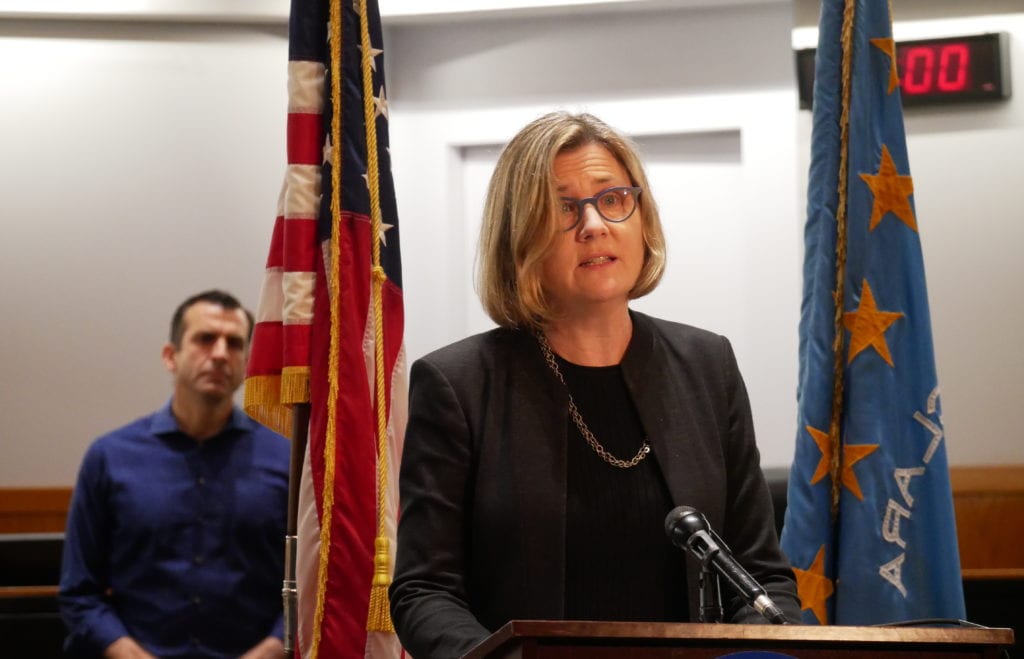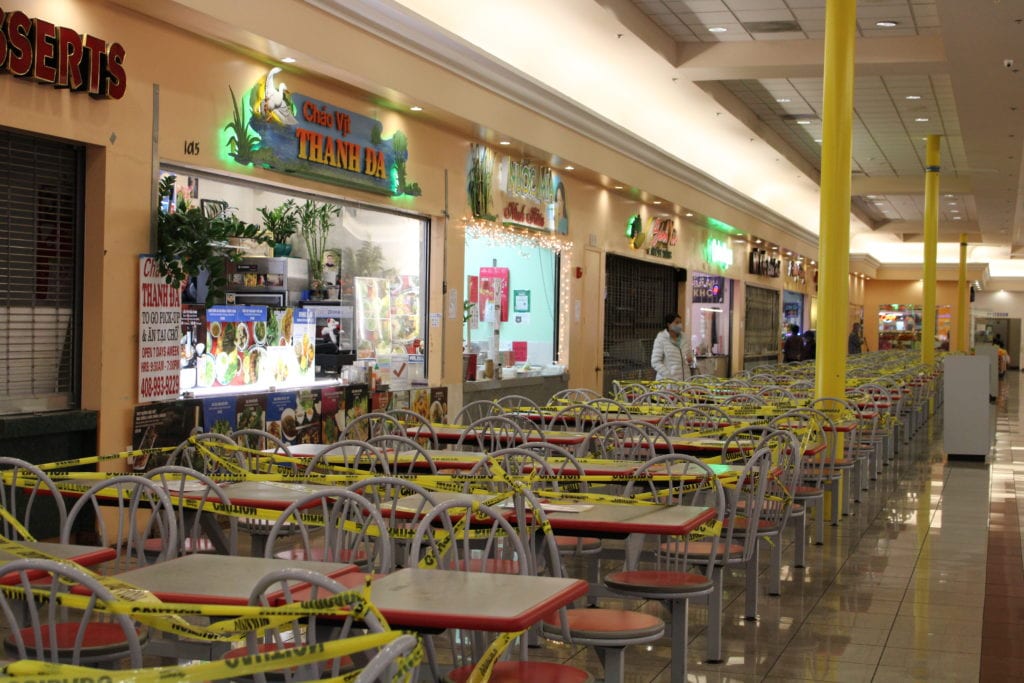For many residents in the South Bay, March 17, 2020 marked the beginning of a year like no other.
One year ago, Santa Clara County and five of its neighbors became the first in the nation to impose a shelter in place order, as the COVID-19 virus silently engulfed the globe. There were 258 confirmed cases across the Bay Area at the time. Three people in Santa Clara County had died from the virus.
“We know that Santa Clara County is the epicenter of this outbreak in the Bay Area and we know that COVID-19 is spreading rapidly,” Santa Clara County Health Officer Dr. Sara Cody said last year. “I recognize that this is unprecedented … But we must come together to do this.”

What came with the following 12 months was uncertainty, loss and grief, as the cases of infections and deaths among the most vulnerable communities continued to rise. As of this week, 1,875 people have died and 113,044 people have contracted COVID-19 in the South Bay.
Weeks of staying at home turned into months. But as the virus reshapes the world, emerging out of the deadly pandemic was the area’s resiliency and newly-formed partnerships to help historically marginalized communities weather exacerbated inequality, local leaders and residents said.
Now as the county is inching its way to reopen schools and businesses, Silicon Valley is optimistic of the future, but not without calls for change and caution.
‘The world was going to change’
The county’s aggressive move to shut down in mid-March had saved lives and decreased the spread of infection, officials said.
Overnight, workers across Silicon Valley were sent to work from home, while thousands of others left jobless. Many local small businesses struggled or completely shut down. Concerts, conferences and sporting events got canceled en masse. Empty grocery shelves and empty schoolyards became familiar sites. Proms, graduations, weddings, funerals passed without celebration.

“We knew the world was going to change,” San Jose Planning Commissioner Rolando Bonilla said in an interview.
But for some, especially those who live in East San Jose and work as essential workers, the stay-home order had little effect.
“What the pandemic demonstrated is that there are two realities in San Jose,” Bonilla said. “We knew COVID was going to impact East San Jose more because many of us couldn’t work from home.”
The Latino population makes up 25% of the county’s population, but it accounts for more than 50% of deaths. A year into the pandemic, residents in East San Jose, downtown area and Gilroy continue to disproportionately grapple with death and unemployment, while big-tech companies are thriving.
“It was not a surprise to us, we knew inequality exists. The pandemic just brought it to the forefront,” said Jessica Paz-Cedillos, executive director of the School of Arts and Culture. “There was no safety net, and we were never set up to face such pandemic.”
To help bridge the gap in access in East San Jose, the school and Mexican Heritage Plaza have transformed into a food distribution site, a testing site and now a vaccination clinic through partnerships with the county and Gardner Health Services. Over the past year, a number of collaborations, including Silicon Valley Strong and South Bay Mutual Aid, have formed across the county to provide COVID-related resources. Others have established teams to bring testing kits and information on COVID to residents at their homes.

For local businesses, the ever-changing orders to shut down, reopen, and shut down again were challenging.
“It was unreal how broad and long the impacts of the orders have been,” said Scott Knies, executive director of San Jose Downtown Association. “The orders, at times, only gave us one day notice, and that was very difficult for businesses.”
The complicated and slow process to receive funding relief also left many felt hopeless, especially for business owners who aren’t native English speakers or face technology barriers, Vietnamese American Business Association President David Duong said.
“If you walk through Century Mall or Vietnam Town now, many stores have shut down for good,” Duong said. “People are still struggling and they are hanging by a thread.”

But some businesses have managed to pivot, with the newly-adopted fees waivers and the loosening of rules on take-out cocktails and outdoor dining.
“It really shows the resiliency of our local businesses,” Knies said. “They were switching up business models and adapting.”
No going back to ‘normal’
Santa Clara County, after months of being locked in the state’s most restrictive tier, moved into the red tier this month. This has eased up some restrictions, allowing for limited indoor dining and religious gatherings to resume.
In addition, with more than 20 COVID-19 vaccination sites popping up across the county, including a mass site at Levi’s Stadium, more residents are getting the jab. The hospitalization rate peaked in December and January, and is now back to levels similar to July last year.
But things can’t go back to “normal,” many said. While schools have started easing to reopening, Santa Clara County Board of Education President Claudia Rossi said more academic and mental health support is needed. Distance learning has pushed an increasing number of students facing inequities to dropout this past year.
“Students are very afraid right now, because they’re returning to a different environment,” Rossi said. “We can’t underestimate the need for mental health support in schools right now.”
Though Silicon Valley will bounce back from the current economic downfall, Bonilla said, Santa Clara County and San Jose need to reprioritize resources to focus on the population that needs it the most.
“This is an opportunity to rectify years of failed investment in East San Jose,” he said. “It’s not that here is more important, this is because we need to help those most in need of resources.”
Working from home will also become a new norm, Knies said. “It’s never going to be the same,” he said. “You’ll see at least a hybrid model everywhere.”
Duong said officials also need to do more for the Asian communities. As the virus spread last year, so did xenophobia and racism against Asians and Asian Americans. Older residents were assaulted and robbed in broad daylight, while businesses are targeted with vandalism.

“They have to make sure that it’s safe for us,” Duong said.
Cautions against growing optimism
With COVID cases continue on a downward trend, Silicon Valley might see even more restrictions lifted, as the county could move into the orange tier next week. But local leaders warn of premature optimism.
“If we’re not careful, we might see another spike, especially after occasions like Spring break and Easter,” said Rossi, who is also a registered nurse. “We need to hang in there a little longer.”
And keep wearing masks, Bonilla added to the sentiment. He almost died from the virus last year. His uncle, who was also infected by the virus, did not survive.
“The virus has yet to be eradicated,” Bonilla said. “We need to keep staying home, wearing masks and keeping our distance.”
Contact Tran Nguyen at [email protected] or follow @nguyenntrann on Twitter.



Leave a Reply
You must be logged in to post a comment.